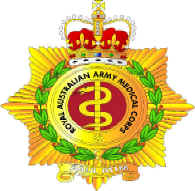
The Royal Australian Army Medical Corps (RAAMC) is the branch of the Australian Army responsible for providing medical care to Army personnel. The AAMC was formed in 1902 through the amalgamation of medical units of the various Australian colonies and was first deployed to South Africa as a small detachment of personnel supporting the Australian Commonwealth Horse during the Second Boer War. The corps has participated in every Australian Army operation since then, including wars and peacekeeping operations. The "Royal" prefix was granted in 1948.

The 1st Division is the main formation of the Australian Army and contains the majority of the Army's regular forces. Its headquarters is in Enoggera, a suburb of Brisbane. The division was first formed in 1914 for service during World War I as a part of the Australian Imperial Force (AIF). It was initially part of the Australian and New Zealand Army Corps (ANZAC) and served with that formation during the Gallipoli campaign, before later serving on the Western Front. After the war, the division became a part-time unit based in New South Wales, and during World War II it undertook defensive duties in Australia before being disbanded in 1945.
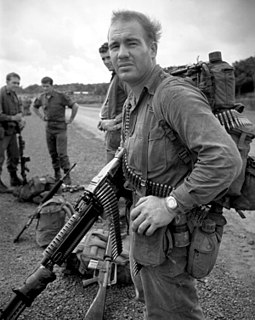
The 1st Australian Task Force was a brigade-sized formation which commanded Australian and New Zealand Army units deployed to South Vietnam between 1966 and 1972. 1 ATF was based in a rubber plantation at Nui Dat, 8 kilometres (5.0 mi) north of Ba Ria in Phuoc Tuy Province and consisted of two and later three infantry battalions, with armour, aviation, engineers and artillery support. While the task force was primarily responsible for securing Phuoc Tuy Province, its units, and the Task Force Headquarters itself, occasionally deployed outside its Tactical Area of Responsibility.

The 3rd Brigade is a combined arms brigade of the Australian Army, principally made up of the 1st and 3rd Battalions of the Royal Australian Regiment. Initially raised in 1903 as part of the post-Federation Australian Army, it was removed from the order of battle in 1906 following the restructure of the field force. It was re-formed in 1914 for service during World War I, taking part in the fighting at Gallipoli and on the Western Front in Europe. During World War II the brigade was used in a defensive role before it was disbanded in 1944. It was re-raised in 1967 for service during the Vietnam War and later went on to provide the nucleus of the deployment to East Timor during the Australian-led intervention in 1999. The brigade is currently based at Lavarack Barracks in Townsville, Queensland.
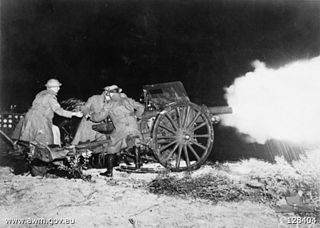
The 1st Regiment, Royal Australian Artillery is a close support regiment attached to the 7th Brigade at Enoggera Barracks in Queensland. The unit was formed in 1914 under the name 1st Australian Field Artillery Brigade, part of 1st Division Artillery during World War I and later served in World War II and the Vietnam War. It is currently re-equipping with M777A2 lightweight towed howitzers.

The 2/12th Field Ambulance was an Australian military unit of the Second Australian Imperial Force, serving during World War II. During their six years of service, over 200 soldiers were killed, the highest figure for a non-combatant unit in Australian history. The majority of the unit's casualties were suffered during the sinking of the hospital ship Centaur in May 1943. During the war, the 2/12th deployed personnel in support of Australian combat operations against the Japanese on Ambon, Timor and in Borneo before being disbanded in 1946.

The 1st Infantry Division Sustainment Brigade is a sustainment brigade of the United States Army based at Fort Riley, Kansas. It provides logistics support to the 1st Infantry Division.
The 1st Close Health Battalion (1CHB) was a unit of the 17th Sustainment Brigade of the Australian Army. It headquartered at the Robertson Army Barracks in Darwin, but had sub-units located in Darwin, Townsville and Brisbane. The unit traced its lineage back to the 1st Field Hospital, which was raised in the 1960s for service as part of Australia's contribution to the Vietnam War. Since then, the unit has changed names twice and personnel have been deployed on numerous peacekeeping and warlike operations throughout Africa, the Middle East and the Asia-Pacific region. The 1st Close Health Battalion disbanded in December 2021 however lives on through the ‘’’1st Health Battalion (1HB)’’’ who have retained the bat symbol. It’s companies have now become their own Battalions excluding 8CHC who was absorbed into 1HB. 8CHC is now 1HB, 11CHC is now 2HB, 8CHC/7PL is now 3HB and 2CHC is now 4HB.
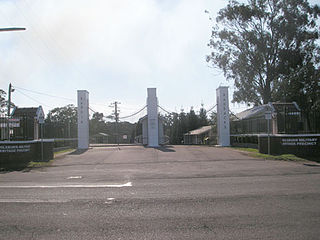
Ingleburn Army Camp was a purpose built camp constructed in 1940 for the Australian Army at Ingleburn, New South Wales, Australia.

The 11th Brigade is an Australian Army brigade which currently comprises most Australian Army Reserve units located in Queensland. The brigade was first formed in early 1912 following the introduction of the compulsory training scheme. Later, as part of the 3rd Division and saw action during World War I on the Western Front as part of the First Australian Imperial Force. In the interwar years, the brigade was re-raised with its headquarters in Brisbane.

8th Brigade is an Australian Army Reserve training formation. It is headquartered in Sydney, and has subordinate units in various locations around New South Wales and the rest of Australia. These units are tasked with delivering basic and initial employment training to Reserve soldiers.
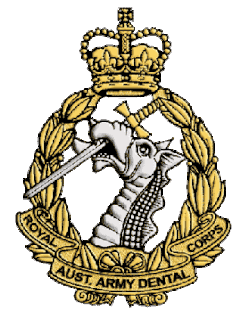
The Royal Australian Army Dental Corps (RAADC) is a corps within the Australian Army. It was formed on 23 April 1943 during World War II as the Australian Army Dental Corps, before being granted the 'Royal' prefix in 1948. Prior to its formation dentists were part of the Australian Army Medical Corps. The role of the RAADC is to provide dental care to army personnel in order to minimise the requirement for the evacuation of dental casualties, to conserve manpower and to reduce the burden of casualty evacuation. In the post-war years, the corps has provided personnel to deployments in Japan, Korea and Vietnam. It has also contributed to peace-keeping operations in Somalia, Rwanda, Bougainville and East Timor.

The 15th Brigade was an infantry brigade of the Australian Army. Originally raised in 1912 as a Militia formation, the brigade was later re-raised in 1916 as part of the First Australian Imperial Force during World War I. The brigade took part in the fighting on the Western Front in France and Belgium during 1916–1918 before being disbanded in 1919. After this it was re-raised as a part-time unit of the Citizens Force in 1921 in Victoria. During World War II the brigade undertook defensive duties and training in Victoria and Queensland, before being deployed to New Guinea in 1943. Over the course of 1943 and 1944, it took part in the Salamaua–Lae, Markham–Ramu campaigns before returning to Australia in late 1944. In mid-1945, the brigade was committed to the Bougainville campaign, before being disbanded following the end of hostilities.
The 1st Australian Logistic Support Group was a ground support unit of the Australian Army during the Vietnam War located at the 1st Australian Support Compound in Vũng Tàu. 1 ALSG commanded logistic support units to all Australian forces in South Vietnam and was composed of engineer, transport, ordnance, medical and service corps units. The unit was initially formed in 1965 as the Australian Logistic Support Company to support the 1st Battalion, Royal Australian Regiment, and was redesignated as 1 ALSG in April 1966 following the deployment of the 1st Australian Task Force as the Australian commitment in Vietnam expanded.
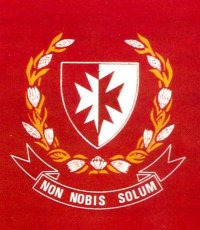
1 Medical Battalion Group is a Medical Battalion in the South African Medical Health Services (SAMHS), part of the South African National Defence Force (SANDF). As a reserve unit, it has a status roughly equivalent to that of a British Army Reserve or United States Army National Guard unit. It is based in the city of Durban in KwaZulu-Natal, South Africa.

The 2/4th Pioneer Battalion was a unit of the Australian Army raised for service during the Second World War. A pioneer unit, the battalion undertook both infantry and engineer tasks. Despite being raised early in the war, the battalion did not see action until the final months, taking part in the Borneo campaign where, as part of the 1st Beach Group, it fought against the Japanese in support of the 9th Division. It was disbanded in early 1946 following the end of hostilities.

The 264th Combat Sustainment Support Battalion is a U.S. Army support battalion stationed at Fort Bragg, North Carolina. The Battalion motto is "Support for Victory". The 264th has deployed overseas to France, Vietnam, Haiti, Nicaragua, Guatemala, Afghanistan, and Iraq.
The 3rd Health Support Battalion is an Australian Army Reserve unit headquartered in Adelaide, South Australia, with sub-units spread across Victoria, Tasmania, South Australia, New South Wales and Queensland. Drawing its lineage from the 3rd Australian General Hospital, which was raised for service during World War I, the unit is tasked with providing Role 2 health support to troops deployed overseas on operations and within Australia on exercise, and has provided medical personnel for a variety deployments in the post-war period, including those to Rwanda, Bougainville, East Timor, Iraq and Afghanistan.

The order of battle of Australian forces during the Vietnam War consisted of a small group of military advisors from 1962, but grew to include an infantry battalion based in Bien Hoa in 1965. This force was then replaced by a two- and later three-battalion task force with supporting arms based at Nui Dat which operated primarily in Phuoc Tuy Province between 1966–71, with logistic elements at Vung Tau. Airforce units committed initially consisted of transport aircraft, but were followed by helicopters and later bombers, while naval forces included destroyers and transport vessels. With the size of Australian forces in Vietnam reaching a peak in early 1968, a drawdown commenced in late 1970, with the bulk withdrawn by early 1972. The last elements returned to Australia in 1973. In total, around 50,000 Australians served during the Vietnam War, including 42,437 members of the Australian Army, 3,310 from the Royal Australian Navy (RAN), and 4,443 from the Royal Australian Air Force (RAAF), with casualties including 519 killed and 2,348 wounded.
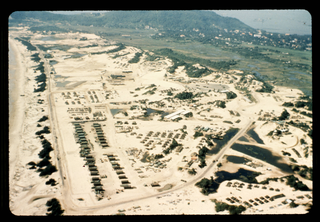
1st Australian Support Compound was a complex of logistics and support bases operated by the 1st Australian Logistic Support Group in Vũng Tàu, Phước Tuy Province, South Vietnam during the Vietnam War.


















